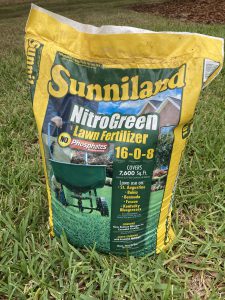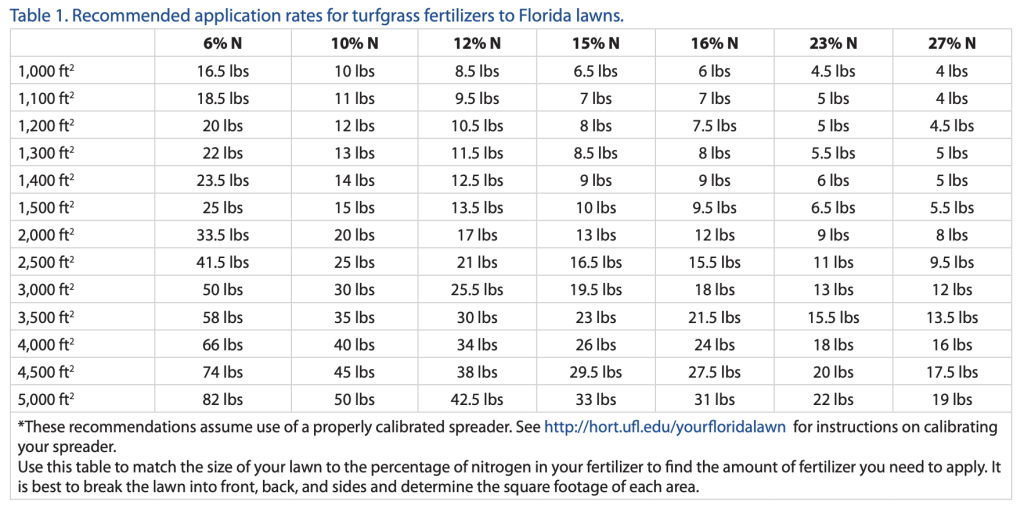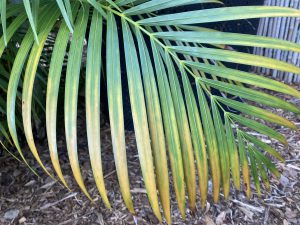Fertilizer can help plants grow but can also have adverse effects on the environment. Be sure to apply best management practices when fertilizing to optimize your plant health without harming our water bodies. Watch the recording of our How to Fertilize Plants webinar here.
The key to having healthy plants is to build good soil. Most Florida soils are sandy and so adding compost on a regular basis and mulching will help increase organic matter, promote beneficial microorganisms, and hold nutrients and moisture in the soil. Practices such as leaving your grass clippings on the lawn and raking leaves into landscape beds are cheap and easy ways to build soil. It is recommended to get a soil test before fertilizing to see how your soil can be improved.

Different plants have special fertilizer needs and restrictions. Before fertilizing, find out if your local municipality has a fertilizer ordinance. A common rule is nitrogen and phosphorus are restricted in the summer from June 1 to Sept. 30 during our rainy season. This is to prevent leaching and runoff of these nutrients into our water bodies where they can increase the growth of algae causing red tide and fish kills. Turfgrass and landscape plants are the main target of the fertilizer restrictions, while edible crops are usually exempt and can be fertilized year-round. Look for summer blends that contain potassium or micronutrients to green up your lawn in the summer.
An ideal turfgrass fertilizer for Florida lawns would contain twice as much nitrogen as potassium and no phosphorus, an analysis of 16-0-8. Turfgrass fertilizers should also contain at least 50% slow-release nitrogen as stated in the guaranteed analysis on the bag. Apply fertilizer when turf is actively growing in the spring in April or May and again in the fall in October if needed. Measure the area of your lawn to determine how much fertilizer to apply. Apply no more than 1 lb N per 1,000 sq ft per application. Do not fertilize within 10 feet of water bodies and use a fertilizer spreader with a deflector shield to prevent fertilization of driveways and sidewalks. Learn more about fertilizing lawns.

Landscape plants such as perennials, shrubs and trees have low fertilizer requirements. Turfgrass fertilizer can be evenly broadcast in your landscape beds too. Hillsborough County and City of Tampa ordinances restrict fertilization of landscape beds with fertilizer containing nitrogen or phosphorus from June 1 to Sept. 30.
Vegetables benefit from a fertilizer that is complete with N-P-K because phosphorus helps with root initiation, such as a 6-6-6. Vegetable fertilizer can be applied before planting by incorporating it into the soil or the applications can be split and some tilled in before planting and the rest applied as a sidedress. Sidedressing is used for long lived plants and the nutrients are beneficial when vegetables start to fruit and flower. Commercial farmers should follow the more detailed recommendations per crop in the Vegetable Production Handbook.
Fruit trees and palms prefer fertilizer blends with higher amounts of potassium. Fertilize on a regular schedule 2 – 4 times per year under the canopy area to the drip line of the plants. To find specific recommendations for fruit tree species visit our FruitScapes website.

If you have any questions, please contact the UF/IFAS Extension Hillsborough County at 813-744-5519 or email hillsmg@mail.ufl.edu.
Follow Us!
We have several ways to connect. Join our UF/IFAS Extension Hillsborough County
Facebook, Florida-Friendly Facebook, YouTube, Instagram, Eventbrite, Blogs, Website
The University of Florida is an Equal Opportunity Institution.
 1
1
